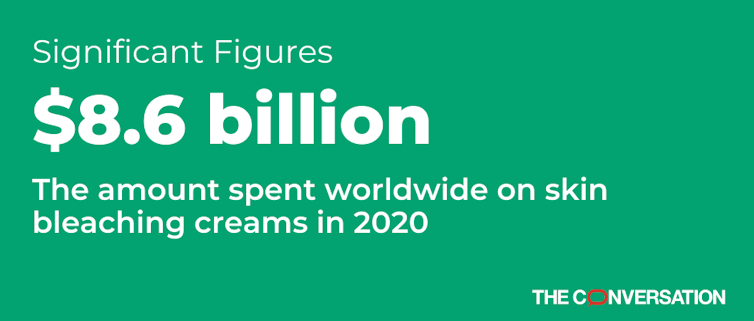
- The idealisation of light skin as the beauty standard affects self-esteem for women around the world.
- About 35 percent of South African women, 77 percent of Nigerians, 27 percent of Senegalese and 60.7 percent of women in Jordan in the Middle East practice bleaching.
- Bleach cream manufacturers face growing pressure to address racism, however, L’Oreal, the world’s largest producer of bleach creams, pledged to remove the words “white,” “fair” and “light” from labels – but will still manufacture these products.

CC BY-ND
The idealisation of light skin as the pinnacle of beauty affects self-esteem for women of colour around the world. In many cultures, skin colour is a social benchmark that is often used by people of colour and whites alike in lieu of race. Attractiveness, marriageability, career opportunities and socioeconomic status are directly correlated with skin colour.
As a result, many women of colour seek chemical remedies to lighten their complexion. They have created a booming global business in bleach creams and injectables valued at US$8.6 billion in 2020; $2.3 billion was spent in the U.S. alone. The market is projected to reach $12.3 billion by 2027.
READ MORE | Revisiting the colourism and pretty privilege conversation amid Pearl Thusi Twitter bedlam... again
In my work in behavioral science and colourism, I studied the phenomenon of skin bleaching during a decade of travel around the world during which I visited every major racial group – and tracked the growth of this industry. The practice has both significant racial implications and health concerns.
A new Netflix documentary called ‘Skin’ explores the practice of skin bleaching in African culture.
A common practice
As I stated during my interview on Oprah’s 2015 “Light Girls” documentary, while bleaching the skin is common, it’s both dangerous and potentially life-threatening because products contain steroids, hydroquinone bleach and mercury. The World Health Organisation warns that skin bleaching can cause liver and kidney damage, neurological problems, cancer and, for pregnant women, stillbirth.
The practice is not new. It became popular in many African countries in the 1950s; today, about 77 percent of Nigerians, 27 percent of Senegalese and 35 percent of South African women bleach their skin. Indian caste-based discrimination was outlawed in 1950, but dark-skinned women (and men) are still persecuted – and fair skin remains a distinguishing social factor, associated with purity and elite status.
In the Middle East, the practice of bleaching is most common in Jordan, with 60.7 percent of women bleaching. The Brazilian government seems to sanction white skin over dark by encouraging immigration from Europe and discouraging persons of African descent.
Light skin is idealised in North America, but the phenomenon is contentious because bleaching is perceived as a desire to be white. So bleaching creams are marketed in the U.S. not to lighten skin, but to “erase blemishes” and “age spots.”
READ MORE | What you need to know about rebranded skin-whitening creams
Their use in the U.S. spiked after the 1967 U.S. Supreme Court ruling that legalised interracial marriage.
In the aftermath of the civil rights movement, dark-complected immigrants from developing countries flocked to the U.S., carrying with them an ideal of light-skinned beauty – and they bleached their skin to attain it.
Ideals of light-skinned beauty stemming from European colonisation contributed to a lucrative bleach cream industry.
READ MORE | How badly is social media affecting women's confidence? Local content creator Oyama Botha gets real
Perpetuating ‘colourism’
Bleach cream manufacturers now face growing pressure to address racism, with activists arguing that their products perpetuate a preference for lighter skin. In 2020, Johnson & Johnson announced that it will no longer sell two products marketed to reduce dark spots that were widely used as skin lighteners.
L’Oreal, the world’s largest producer of bleach creams, pledged to remove the words “white,” “fair,” and “light” from labels – but it will still manufacture these products.
Some among African countries have moved to ban bleaching creams. The success of the blockbuster film “Black Panther” has likewise sparked a movement celebrating dark skin, with hashtags including #melaninpoppin and #blackgirlmagic.
As I see it, public education and activism on this issue must prevail to protect the health and self-esteem of women of colour. The failure of either will only prolong the problem – while sustaining an $8.6 billion bleach cream beauty industry.
This article is republished from The Conversation under a Creative Commons license. Read the original article.
Follow us on social media: Facebook, Twitter, Instagram
Sign up to W24’s newsletters so you don't miss out on any of our stories and giveaways




 Publications
Publications
 Partners
Partners











